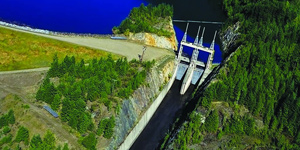 Construction began September 17, 1964 and storage became fully operational July 31, 1967.
Construction began September 17, 1964 and storage became fully operational July 31, 1967.
Reservoir Elevations
- Normal full pool: 577 meters (1,892 feet)
- Normal minimum pool: 547 meters (1,794.2 feet)
- Surface area at full pool: 7,290 hectares (18,000 acres)
- Total storage capacity: 1.77 kilometers3 (1,432,400 acre-feet)
- Usable storage capacity: 1.73 kilometers3 (1,400,000 acre-feet)
- Treaty storage commitment: 1.73 kilometers3 (1,400,000 acre-feet)
Dam, Earthfill
- Crest elevation: 581 meters (1,907 feet)
- Length: 792.5 meters (2,600 feet)
- Approximate height above riverbed: 39.6 meters (130 feet)
- Maximum spillway capacity: 1,350 meters3/sec (47,700 cfs)
- Maximum discharge tunnels capacity: 570 meters3/sec (20,000 cfs)
Power Facilities
Read more information about BC Hydro's Columbia Region Facilities.